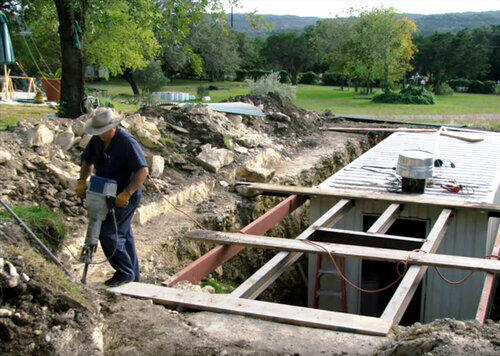5 Tips for Planning Your Container Root Cellar or Storm Shelter

Edit: Please note that Super Cubes does not recommend burying containers without working with an engineer to ensure your container remains structurally sound when in place and complies with your local zoning. Also, please test buried containers for radon.
Here’s your idea: Get a steel container and bury it as a root cellar, storm shelter, or both. You have the land. Now you need a plan. Here are the five things you need to consider to make your container cellar or shelter a reality:
Zoning. Are there any state, county, or city zoning laws that would restrict where or how you bury a container? This may vary depending on where you are, what the ground is like in your area, and how far into the ground you want to go. You can go the range from buried underground, nestled into a hill or embedding the container just far enough into the ground to be secure. Either way, zoning rules may apply. Start with a quick search of your city and county websites, then follow up with phone calls to offices listed on the sites. Take notes on the calls—and as decisions are made, “get it in writing” if you can.
Placement. Is your plan to bury the container completely? Just far enough that a tornado won’t send it to Oz? In working outplacement details, be sure to think through how you will use your container. If it will be a root cellar, will you build your container into a hill with steps and a door? If it will be an underground storm shelter, how will you provide access in and out? Keep in mind that the more deeply a container is buried, the greater the planning.
Structure. If you will bury your container, even partially, how will you ensure that it withstands the pressure of earth? Containers were made not to be buried, but to be stacked on a ship. Only the four corner posts of a container are load-bearing, with the sides strong enough to support only the roof. You’ll need to plan on building a retaining wall around the container location. Be sure to include drainage so that heavy rains won’t leave your container submerged in water. If your cellar or shelter calls for completely covering your container’s roof, you’ll also need to build a platform to push all the weight to the 4 corner posts (products are on the market to do this). Never simply bury a container or it will collapse.
Moisture. Containers are wind and watertight, but think about how you will prep your buried container against earthen moisture. The container floor has treated plywood on steel cross-members. You will want to seal under the floor—and probably will want to set it on a cement slab foundation. In addition, you will need to seal your container with roofing tar, plastic tarps, or truck bed liners (such as RhinoLinings). A little research will help you find the most cost-effective solution for your container use and location.
Ventilation. If you’re turning your container into a storm shelter, you’ll want to make sure it will have good ventilation and airflow for the people who will use it. You’ll also want to add an extra door—ideally a man-door with a panic bar so it can be opened safely from inside and so that no one can be accidentally locked in.
For an example of one being installed, see this video. They approached some of the issues listed above a little differently, but it still provides some great ideas. It appears that they put the container in an area with solid rock, so the rock walls provided the support that most people would have to build in place.
Once you have your container cellar or shelter in place, the rest is pretty easy—making sure your root cellar has the right humidity level for vegetables or that your shelter is outfitted to work well as a storm refuge. If you’re just beginning to start your cellar or shelter project, please keep in mind that Super Cubes offers a variety of kits to help you modify your container—and we’re always happy to provide friendly advice as well.
April 2, 2020
